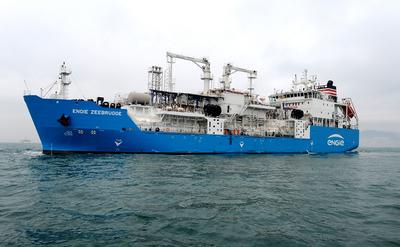ENGIE, Fluxys, Mitsubishi Corporation, and NYK have taken delivery of the world's first purpose built liquefied natural gas bunkering vessel (LBV) from Hanjin Heavy Industries & Construction Co. Ltd., at the Yeongdo shipyard in Busan, Korea. She will run on LNG for her maiden voyage, after a few days of loading LNG delivered by trucks at the shipyard.
Home port Zeebrugge, Belgium
Zeebrugge in Belgium will be the home port of the vessel, which has been named ENGIE Zeebrugge accordingly. From there, the 5,000 m3 LNG capacity LBV will supply LNG as a marine fuel to ships operating in Northern Europe. The two LNG-fueled pure car and truck carriers (PCTC) operated by United European Car Carriers will be its first customers. ENGIE Zeebrugge will load LNG at Fluxys' LNG terminal in Zeebrugge, where small carriers with capacities from 2 000 m3 can dock at the recently commissioned second jetty.
Milestone in the development of the European LNG bunkering chain
As international regulations on emissions for ships tighten, LNG is expected to become an important alternative fuel for the maritime industry. Currently, the bunker market amounts to approximately 250 million tons of heavy fuel oil per year. The challenge in making LNG grow in the bunker market is to develop sufficient supply infrastructure to support the increasing number of LNG-fueled ships that are expected to come into operation. ENGIE Zeebrugge, in this respect, marks a milestone in the development of the European LNG bunkering chain. While LNG-fueled ships up to now have been largely dependent on fixed bunker locations or the limited bunkering capacity of LNG trailers, ENGIE Zeebrugge, the first purpose built LNG bunkering vessel, has been designed to service a variety of LNG-fueled ships.
Gas4Sea: marketing LNG as a marine fuel
Last September, ENGIE, Mitsubishi Corporation and NYK launched Gas4Sea, a brand name for marketing ship-to-ship LNG bunkering services worldwide, firstly via the ENGIE Zeebrugge in Northern Europe. Under this common brand, the three partners intend to support the development of LNG as a marine fuel, thus contributing to an environmentally friendly maritime industry.
Ever more stringent emission regulations for ships
The requirements applicable to ships for controlling NOx , SOx and CO2 emissions are getting stricter year by year. As from January 2015, regulatory emission limits for SOx have been reduced by the International Maritime Organisation (IMO) from 1.0% to 0.1% in the so-called Emission Control Areas (ECAs, which include the North Sea, the Baltic Sea area and areas around North America). More recently, according to a decision by IMO, emission limits for SOx will be reduced outside the ECAs from the current 3.5% to 0.5% as of January 2020.
Distinctive environmental benefits of LNG
Due to its favourable emission profile, the widespread adoption of LNG as a marine fuel is key to curb emissions of SOx and other harmful emissions in the shipping industry. As it goes, the operation of LNG-fueled ships can result in a reduction of nearly all emissions of SOx and particulate matter (PM), compared to ships powered with conventional fuels. LNG use can also reduce CO2 emissions by up to 25% and NOxemissions by more than 80% compared to gasoil.
ENGIE Zeebrugge / Facts & figures
Length overall: 107.60 meters
Breadth: 18.40 meters
Depth: 9.00 meters
LNG capacity: 5,000 m3
Gross tonnage: 7,403 tons
Main engine: Dual Fuel (marine gas oil, marine diesel oil, and LNG)
CountryFlag: Belgium
Class: Bureau Veritas
Shipyard: Hanjin Heavy Industries & Construction Co. Ltd., Yeongdo Shipyard (Pusan) Ship management: NYK Energy Transport (Atlantic) Ltd. (NYK LNG Shipmanagement (UK) Ltd.)
Home port Zeebrugge, Belgium
Zeebrugge in Belgium will be the home port of the vessel, which has been named ENGIE Zeebrugge accordingly. From there, the 5,000 m3 LNG capacity LBV will supply LNG as a marine fuel to ships operating in Northern Europe. The two LNG-fueled pure car and truck carriers (PCTC) operated by United European Car Carriers will be its first customers. ENGIE Zeebrugge will load LNG at Fluxys' LNG terminal in Zeebrugge, where small carriers with capacities from 2 000 m3 can dock at the recently commissioned second jetty.
Milestone in the development of the European LNG bunkering chain
As international regulations on emissions for ships tighten, LNG is expected to become an important alternative fuel for the maritime industry. Currently, the bunker market amounts to approximately 250 million tons of heavy fuel oil per year. The challenge in making LNG grow in the bunker market is to develop sufficient supply infrastructure to support the increasing number of LNG-fueled ships that are expected to come into operation. ENGIE Zeebrugge, in this respect, marks a milestone in the development of the European LNG bunkering chain. While LNG-fueled ships up to now have been largely dependent on fixed bunker locations or the limited bunkering capacity of LNG trailers, ENGIE Zeebrugge, the first purpose built LNG bunkering vessel, has been designed to service a variety of LNG-fueled ships.
Gas4Sea: marketing LNG as a marine fuel
Last September, ENGIE, Mitsubishi Corporation and NYK launched Gas4Sea, a brand name for marketing ship-to-ship LNG bunkering services worldwide, firstly via the ENGIE Zeebrugge in Northern Europe. Under this common brand, the three partners intend to support the development of LNG as a marine fuel, thus contributing to an environmentally friendly maritime industry.
Ever more stringent emission regulations for ships
The requirements applicable to ships for controlling NOx , SOx and CO2 emissions are getting stricter year by year. As from January 2015, regulatory emission limits for SOx have been reduced by the International Maritime Organisation (IMO) from 1.0% to 0.1% in the so-called Emission Control Areas (ECAs, which include the North Sea, the Baltic Sea area and areas around North America). More recently, according to a decision by IMO, emission limits for SOx will be reduced outside the ECAs from the current 3.5% to 0.5% as of January 2020.
Distinctive environmental benefits of LNG
Due to its favourable emission profile, the widespread adoption of LNG as a marine fuel is key to curb emissions of SOx and other harmful emissions in the shipping industry. As it goes, the operation of LNG-fueled ships can result in a reduction of nearly all emissions of SOx and particulate matter (PM), compared to ships powered with conventional fuels. LNG use can also reduce CO2 emissions by up to 25% and NOxemissions by more than 80% compared to gasoil.
ENGIE Zeebrugge / Facts & figures
Length overall: 107.60 meters
Breadth: 18.40 meters
Depth: 9.00 meters
LNG capacity: 5,000 m3
Gross tonnage: 7,403 tons
Main engine: Dual Fuel (marine gas oil, marine diesel oil, and LNG)
CountryFlag: Belgium
Class: Bureau Veritas
Shipyard: Hanjin Heavy Industries & Construction Co. Ltd., Yeongdo Shipyard (Pusan) Ship management: NYK Energy Transport (Atlantic) Ltd. (NYK LNG Shipmanagement (UK) Ltd.)









